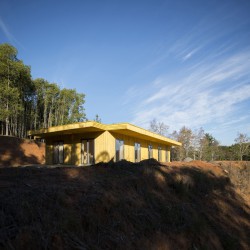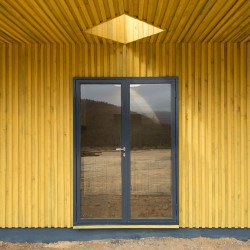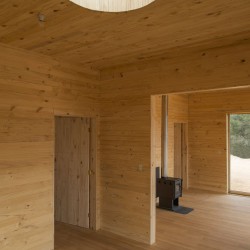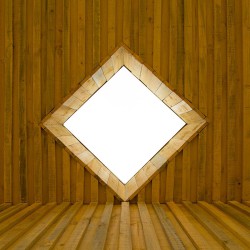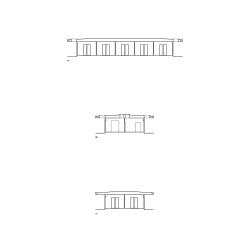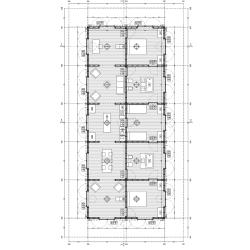Pezo von Ellrichshausen . fotos: © Pezo von Ellrichshausen
Aún cuando la casa que proyectamos originalmente para un uso permanente, luego de importantes cambios en la familia, se transformara en esta otra ya no de concreto, un tercio más pequeña y de uso eventual, no sólo intentamos que su presencia luminosa y distendida se mantuviera intacta sino que su trazado siguiera fielmente una suerte de huella ficticia del proyecto anterior.
Sobre el mismo podio artificial existente, la nueva casa se extiende horizontalmente siguiendo el paso de un sinuoso río a los pies del cerro. La posición dominante de esta pieza establece una doble frontalidad que su interior articula mediante una secuencia regular de habitaciones iguales. Hacia el paisaje abierto se despliega una serie continua de funciones comunes y hacia el cerro inmediato otra discontinua de funciones individuales. Cada frente tiene cinco habitaciones con un régimen de aperturas en los muros exteriores indiferente a su orientación o a su programa y otro régimen irregular de aperturas interiores relativa a los grados de privacidad entre cada recinto. Ambas secuencias se estructuran mediante otro sistema de aperturas en los cielos que tensionan diagonalmente la percepción de la profundidad de la planta. El centro de toda la casa se desdibuja mediante dos perforaciones tangenciales que apenas unifican las habitaciones de cada lado. El cielo horizontal perforado se extiende más allá del interior y separa los cuatro frentes con una sombra pesada. La totalidad de la estructura es de pino impregnado. Los muros exteriores están revestidos con tablas teñidas sin cepillar y los interiores con tablas más lisas y suaves, y con el mismo cuadro de Petoruti que heredaría la familia. Musil decía que toda cosa que desea aproximarse íntimamente a otra tiene una banda elástica atada a ella, que se tensa cuando se extiende. De lo contrario, las cosas podrían terminar atravesándose unas a otras. Al parecer, en todo movimiento, en toda actividad, existe un elástico que afortunadamente nunca nos deja hacer todo lo que queremos.
PEZO VON ELLRICHSHAUSEN, CASA MERI, FLORIDA, 2014
Nombre proyecto: Casa Meri
Programa: Residencia Privada
Ubicación: Puente 3, Florida, Chile
Cliente: Maria Rosa Gonzales, Alejandro Woloszyn
Arquitectos: Mauricio Pezo, Sofía von Ellrichshausen
Colaboradores: Simon Guery, Philpe Kempfer, Orlando Hartmann, Luisa Rocco
Construcción: Ricardo Ballesta
Cálculo estructural: Luis Mendieta
Instalaciones: Luis Valenzuela, Daniel Garrido
Estructura: Pino impregnado
Terminaciones exteriores: Entablado pino bruto teñido
Terminaciones interiores: Entablado pino machiembrado, pavimento eucaliptus
Pisos: 1
Normativa terreno: Area rural
Superficie sitio: 180.000 m2
Superficie construida: 170 m2
Costo: 560 US$/m2 (13 UF/m2)
Fase proyecto: 2013
Fase construcción: 2013-2014
Fotografía: Pezo von Ellrichshausen
Even though the house we originally projected for a permanent use, after important changes in the family, it was transformed into this other house, no longer in reinforced concrete, a third smaller and for a temporary use. We did not only try to keep its luminous and relaxed presence but to trace it literally on top of a kind of fictitious footprint of the previous project. On top of the same existing artificial podium, the new house extends itself horizontally as an attempt to follow the flow of a sinuous river at the foot of the hill. The dominant position of this piece establishes a double front articulated in its interior by a regular sequence of identical rooms. Towards the open landscape there is a continuous arrangement of common functions and to the immediate hill there is another discontinuous one with individual functions. Each side has five rooms with a system of openings in the exterior walls indifferent to orientation or program and another system of apertures in the interior walls that is relative to the degree of privacy from one room to the other. Both sequences are structured by another system of ceiling apertures that forces diagonally the perception of the plan’s depth. The center of the whole house is blurred by a couple of tangential perforations that unify the rooms at every side. The perforated ceiling extends beyond the interior and separates each of the four sides with heavy shades. The totality of the structure is impregnated pine. The exterior walls are clad with dyed rough pine boards and the interiors with soften and flat boards, with the same Petoruti painting inherited by the family. Musil said that every thing that wants to closely approximate another has an elastic band tied to it, which tenses when extended. If not, things could end up intersecting each other. It seems that in every movement, in every activity, there is an elastic that fortunately never let us entirely do what we want.




